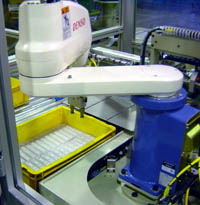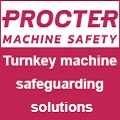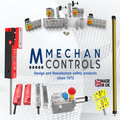
Posted to News on 26th Mar 2007, 17:39
Robotic packaging cell increases output four-fold
AA Robotics has designed and installed an automated packaging system based on Denso robots, enabling Stanley Tools to maximise the benefits of lean manufacturing, reduced stock holding and faster deliveries for blade dispensers.

An innovative new robotic process at Stanley Tools has significantly reduced handling operations and improved productivity in knife blade dispenser packaging operations. AA Robotics, the robot division of Aylesbury Automation, designed and installed an automated packaging system using Denso robots to maximise the benefits of lean manufacturing, reduced stock holding and shortening delivery lead times of blade dispensers for Stanley Tools at Rotherham.
Stanley Tools manufactures and markets tools, hardware and speciality products worldwide for both the home improvement market and industrial and professional use. Founded by Frederick Trent Stanley in 1843 in Connecticut, USA, to manufacture door bolts and other wrought iron products, Stanley Tools is now a global brand. Demand for replacement blades for the Stanley Knife is growing, and it was this increased demand that led to the requirement for improved automation.
Four-fold increase in output
The original machine cycle, plus machine loading time, has been reduced by 75 per cent thanks to the new automated technology. This allows Stanley Tools to process and pack four times more products per hour with a 100 per cent quality check of component parts. Previously a semi-automatic machine had been used for the assembly and packaging process, which involved routine manual handling of components into the machine.
Nick Vickers, Plant Manager of Stanley Tools, comments: "The process we had was quite labour-intensive. With demand for replacement blades increasing, and bearing in mind the health and safety aspects of increased manual handling, robotic automation was the obvious route to follow. AA Robotics was able to supply a solution that performs the task with the minimum of manual intervention. What is more, we have the flexibility to change the assembly and packaging process easily, as products and demands change."
Robots load and palletise
The new automated process uses robots to load and unload components. A storage hopper trickle-feeds plastic cases on demand into a vibratory bowl feeder. After being sorted in the bowl into one of two orientations, the cases are delivered onto an infeed conveyor. Here the first Denso robot picks up a case and manipulates it so that sensors can check its orientation and condition; components failing a specification check are rejected. The robot then presents the case to the next stage of the assembly operation.
Dispensers are also fed from a vibratory storage hopper and bowl into correct orientation for insertion into the cases. The blades from the blade-grinding machine are delivered in trays and automatically fed by conveyor into an upload station where they are prepared for loading into the cases. At the same time, a strip of steel feeds into a press where it is cut to form the spring that is inserted in the case behind the blades.
The case is then closed, and checks are made to ensure the spring and blades are correctly inserted. A final robot palletises the cases, six layers deep with 28 cases per layer, in a tote bin that is orientated correctly for final packaging. Interestingly, there is no pause in overall throughput when the tote bin is changed, as the palletising robot temporarily stacks cases from the assembly process in a buffer. When the new tote bin is in place, the robot is fast enough to load the buffered cases in the bin in between loading the freshly assembled cases.
Experience and innovation
Howard Walker, Senior Engineer at Stanley Tools, comments: "AA Robotics' designers brought a great deal of experience in automated assembly and robotic packaging to the job, and they have succeeded in providing a solution that is extremely efficient and cost-effective."
During the final stages of the project, the engineers at AA Robotics were able to make small changes to the robot programs to enable the robots' actions to be varied slightly to improve the machine's performance. To make the same changes with a traditional automated assembly and inspection machine would have taken far longer and been considerably more expensive. In addition, the robot was able to perform additional actions that might otherwise have necessitated the installation of extra pneumatic axes - all by making small changes to the program alone.
AA Robotics believes that one of the main reasons that it won the contract was that it was more innovative than its competitors - which is increasingly important in today's highly price-competitive market.
Want the latest machine building news straight to your inbox? Become a MachineBuilding member for free today >>

















